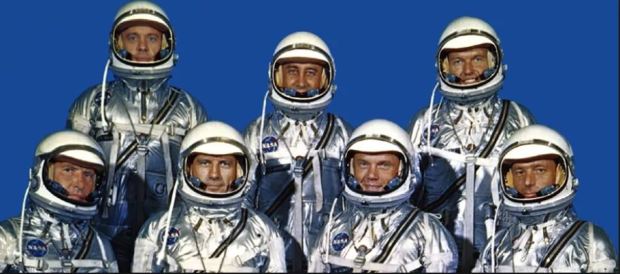
On April 9, 1959, NASA’s first administrator, Dr. Keith Glennan, announced the names of the agency’s first group of astronauts at a news conference in Washington, D.C. Now known as the “Original Seven,” they included three Naval aviators, M. Scott Carpenter, Walter M. Schirra Jr., and Alan B. Shepard Jr.; three Air Force pilots, L. Gordon Cooper Jr., Virgil I. (Gus) Grissom, and Donald K. (Deke) Slayton; along with Marine Corps aviator John H. Glenn Jr. This group photo of the original Mercury astronauts was taken in June 1963 at the Manned Spacecraft Center (MSC), now Johnson Space Center, in Houston, Texas. The astronauts are, left-to-right: Cooper, Schirra, Shepard, Grissom, Glenn, Slayton and Carpenter.

Mercury represented NASA’s first human spaceflight program, with the aim to see if humans could function effectively in space for a few minutes or hours at a time.
Members of the group flew on all classes of NASA manned orbital spacecraft of the 20th century — Mercury, Gemini, Apollo, and the Space Shuttle. Gus Grissom died in 1967, in the Apollo 1 fire.

The others all survived past retirement from service. John Glenn went on to become a U.S. senator and flew on the Shuttle 36 years later to become the oldest person to fly in space, age 77. He was the last living member of the Mercury 7 team when he died in 2016 at the age of 95.

On Oct. 7, 1958, the space agency announced plans to launch humans into space. Project Mercury became NASA’s first major undertaking. The objectives of the program were simple by today’s standards, but required a major undertaking to place a human-rated spacecraft into orbit around Earth, observe the astronaut’s performance in such conditions and safely recover the astronaut and the spacecraft.
President Dwight D. Eisenhower’s decision that the military services could provide the pilots simplified the astronaut selection process. From a total of 508 service records screened in January 1959, 110 men were found to meet the minimum standards. This list of names included five Marines, 47 Naval aviators and 58 Air Force pilots.
President Dwight D. Eisenhower insisted that all candidates be test pilots. Because of the small space inside the Mercury spacecraft, candidates could be no taller than 5 feet 11 inches (180 cm) and weigh no more than 180 pounds (82 kg). Other requirements included an age under 40, a bachelor’s degree or the professional equivalent, 1,500 hours of flying time, and qualification to fly jet aircraft.

NASA officials were pleased so many agreed to participate in the man-in-space project. At the introductory news conference, Shepard said that he was eager to participate as soon as he learned NASA was seeking pilots for spaceflight.
NASA introduced the astronauts in Washington on April 9, 1959. Although the agency viewed Project Mercury’s purpose as an experiment to determine whether humans could survive space travel, the seven men immediately became national heroes and were compared by Time magazine to “Columbus, Magellan, Daniel Boone, and the Wright brothers.”Two hundred reporters overflowed the room used for the announcement and alarmed the astronauts, who were unused to such a large audience.


Donation
I am passionate about my site and I know you all like reading my blogs. I have been doing this at no cost and will continue to do so. All I ask is for a voluntary donation of $2, however if you are not in a position to do so I can fully understand, maybe next time then. Thank you. To donate click on the credit/debit card icon of the card you will use. If you want to donate more then $2 just add a higher number in the box left from the PayPal link. Many thanks.
$2.00
Sources
NASA
SpaceOrg.com
Reblogged this on History of Sorts.
LikeLike